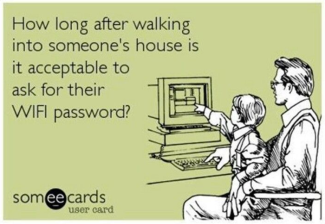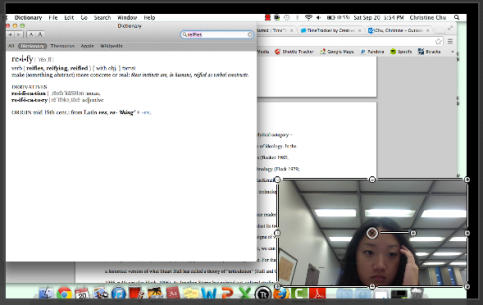As someone who thought she had better control over new media than most, the media diet proved me wrong and showed me how several aspects of my life revolve around it. New media is constantly incorporated with the tasks I need to complete, which is ironic since it tends to lead me straight to distractions and take me away from the concentration my tasks at hand call for. New media is intertwined in my life more than ever before and I was completely oblivious to my interactions with it and how it affected my personal sense of self and presence.
With the start of a day I am already interacting with a form of new media – my iPhone’s alarm clock. The day is easily experienced through several additional encounters from checking the time on my phone, to updating my school inbox, to finding my way to a new farmer’s market (thanks, Google Maps), to getting my morning news, and ending my day with a few relaxing moments on Pinterest. Even without these activities I choose to engage in voluntarily, new media is constantly incorporated with the tasks I have no choice but to complete. Homework assignments, school organization responsibilities (i.e. I control my sorority’s email account), internship duties, full time job searches…the list could go on.
As my chosen channels of communication technology and new media unravel like the layers of an onion, I’m beginning to realize the planned necessity that’s become incorporated into my daily life. The idea that new media, by nature, must be combined with tasks I have as a full time student reminisces our course discussion on planned aspects of communication technology. As a student whose courses fully encourage and engage in use of online resources like Sakai, I automatically default toward the need to use utilize new media. It is no longer a choice, but rather a must-do. Without even trying, I am subjected to a planned requirement just based on the nature of course structure or my sorority’s necessity to communicate with its members via email. From here on out, I immediately recognized that it goes back to our class discussion on planning and how it’s a virtue of new media. Sites like Google mail and Twitter make it easy for us to maintain immediacy through notifications and iPhone banner alerts, all of which are built in factors designed to capture our attention and keep us coming back.
In my personal use of new media, my phone is what keeps me hooked in particular. It seems cliché to say, but it’s an extension of my physical body as it’s constantly in my hand. Like I mentioned in my findings, I recognized my perpetual crave to click my home screen on even before the media diet was assigned. But it doesn’t end there. I found myself constantly looking at some type of screen. My phone is essential during the commutes to my internship, and let’s not forget to mention my laptop’s necessity for emails and school work or computer monitors at work.
After some reflection, I came to the revealing conclusion that a majority of my small triumphs and daily joy stemmed from a type of communication technology and new media somehow. From receiving praise at my internship for the hard work I’ve accomplished, to hilarious group text messages with my best friends, to a quick episode of Friends to unwind after a day of exams and meetings. Things like group Facebook messages and Snap Chats are just the tip of the iceberg when it comes to staying connected with my friends and family. Hopefully this goes without saying, but nothing can replace meeting up with friends and getting dinner with them or being able to spend quality time with my parents at home. These face-to-face actions give me permanent joy and are always something I have to look forward to, but new media provides me with temporary joy until I am able to coordinate a time to spend time with people I love. Considering our busy schedules, I am left with new media to appease me until then.
All of my little ticks, realizations, and class discussions contributed to my personal sense of self as I lived my self established media diet guidelines for 72-hours. Receiving temporary joy, using new media to complete my tasks as a student and intern, and using it for my own benefit just solidified the connection between me and communication technology. My sense of self is engulfed with just that. It revolves around the consequences, my reactions, and the irony that is born from it.
For my fifth and final media diet guideline, I chose to implement the use of Self Control while I worked on school related assignments in efforts to avoid my ever present temptation to check Facebook, Twitter, and my email accounts. It doesn’t escape me that I am using new media, the Self Control app, as a means to prevent using new media. I find this particular moment from my field notes as the ultimate example of how my life revolves around it. My attempts at distancing myself from new media were only strengthened by my need to use another form.
The irony of it all relates so much back to a concept that Valerie Strauss and Clay Shirky bring to our attention. Shirky’s analogy of an elephant and its rider stuck with me and created a parallel that I recognized within my personal new media use. Shirky describes how the elephant, much like emotion, are stronger and often overtake our intellect, the rider. Even though the rider is capable of planning ahead and acknowledging the possible consequences, the elephant consistently comes out on top. For me, the analogy aligned with my wish-washy self-control. It would be sad to say that I have zero ounces of self-control against the temptations of social media not only a college student, but also a young adult in her senior year (which isn’t the case…I have self control). Although more often than not, I find myself succumbing to my desire to put off course readings and switch gears to an unscientific BuzzFeed quiz or the “urgent” red notification that sucks me back online.
My media diet revelation also helped me make a connection to Paul Miller’s A Year Offline. Balance is necessary in order to maintain healthy levels of experiencing what is around you and what is shared with you digitally. Completely unplugging myself is a bold move and counterproductive. I like to think of when the telephone was first introduced. People did not question its purpose or their personal existence, but rather adopted the telephone and took advantage of its purposes to communicate efficiently and more directly. I think new media should be treated the same. I will only set myself up for failure if I choose to remove myself from the digital sphere as I would leave myself with no effective ways for potential employers to reach me, especially since I’m a senior and on the hunt for a full time job. I would be completely disconnected from the Loyola community and the crime alert emails and professor notifications posted via Sakai.
Overall, Shirky’s response to Nicolas Carr was the defining course reading that tied my entire media diet experience together. He states that Carr seems to misplace his essay’s focus by exploring whether or not sacrifice exists with new media. However, Shirky believes that sacrifice is inevitable with the “transformation of the media landscape.” Therefore, the question is no longer, “Is there sacrifice?” but rather, “Is the sacrifice worth it? If not, what can we do to make it worth it?” Shirky’s response resonates with me because I feel as though it is the answer to my media diet experience. It ties my field notes, my 72-hour diet, and course readings together in one simple question, is my new media worth the sacrifice?
I can confidently say I believe it is.
The countless times I’ve been able to reach my dad via text message is truly a feat considering his hectic work schedule as a Chicago chef. Not to mention the payoff from the several efforts to network and establish relationships with employers during my time abroad through email. I can’t place a price on the value I have in order to stay connected with my dad or to prepare for my future. Both concepts have only evolved and improved thanks to the use of new media in a smart way that makes it all worth my time. In order to take advantage of the ever-evolving technology it’s time I reevaluate my self-control, and based off of my media diet results, begin functioning in such a way that new media no longer uses me. Between wearing my watch and utilizing the Self Control app, I believe new media’s omnipresence can slowly diminish to create balance. Maybe the only thing my tick needs are small, brief actions to produce big, enduring improvements.



